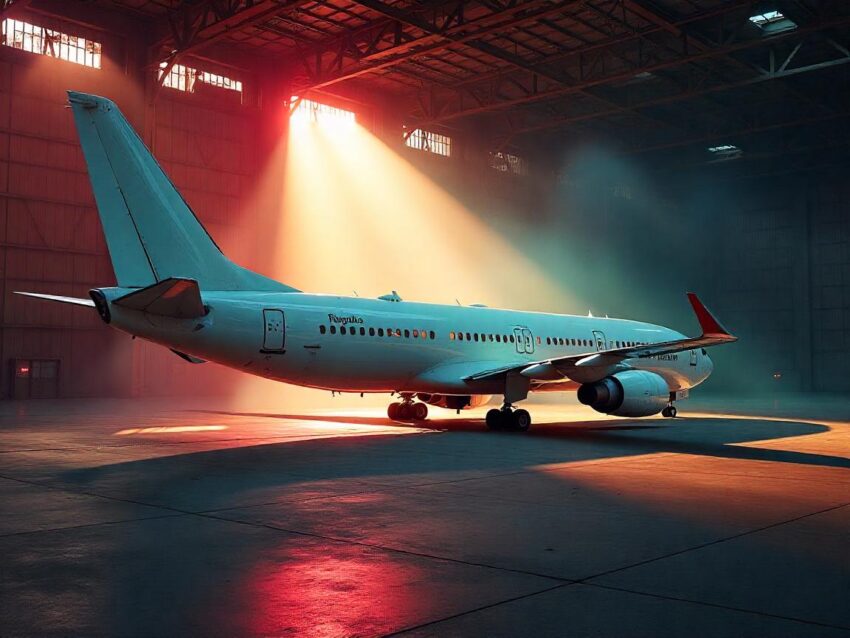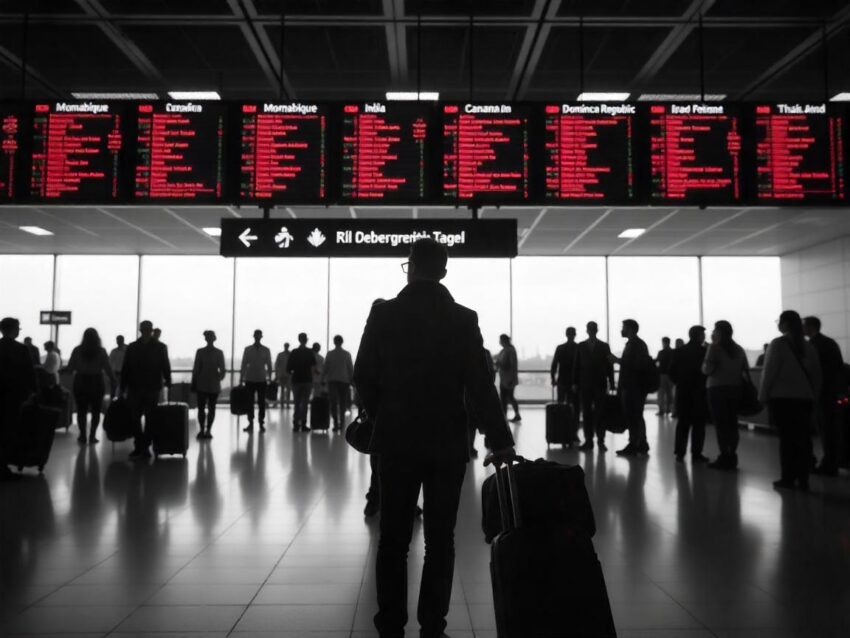Wednesday, June 18, 2025

What will happen to the global airline, cruise, hotel, and travel industry if America enters the Israel-Iran conflict? That question now hangs heavy over the world. The stakes are no longer regional—they are global. And the entire world is watching now.
Tensions between Israel and Iran have already rocked the Middle East. But if America enters, the entire travel landscape could shift overnight. The impact won’t stop at borders. The dominoes will fall fast—from the skies to the seas, from luxury resorts to cruise terminals. And the global airline, cruise, hotel, and travel industry stands at the front line.
Meanwhile, new reports show deep tremors already spreading across West Asia, the Middle East, and even European tourism sectors. Fear is rising. Bookings are stalling. Governments are updating travel advisories by the hour. Flights are being diverted. Travelers are canceling. And cruise lines are redrawing their routes in real time.
If America enters the conflict, expect fallout not just in military terms—but in economic and emotional impact across the entire planet. The hotel chains, cruise ports, and airline hubs are already preparing for the worst.
This is no longer just about geopolitics. This is about people, movement, and the freedom to explore. The world is not just holding its breath—it’s counting the cost.
Because if the worst happens, it won’t just change West Asia. It could transform the entire travel industry. And yes, the whole world is watching now.
The world is standing still. One decision from the White House Situation Room could bring West Asia’s tourism economy crashing down. With US President Donald Trump now poised to intervene in the escalating Israel-Iran war, the ripple effects across the global travel industry are becoming dangerously real.
Airlines are rerouting. Travelers are cancelling. Governments are issuing fresh warnings. And the once-thriving corridor of Middle East tourism is spiraling into crisis.
This isn’t just a conflict on the ground. It’s a storm taking flight—one that could reroute the future of travel for millions.

Airlines Scramble as Skies Over West Asia Become War Zones
As fighter jets prepare for takeoff and long-range bombers head toward strategic airspace, airlines are already feeling the heat. Commercial carriers are avoiding Iranian, Iraqi, and Israeli skies entirely. Rerouted flights mean longer routes, higher fuel costs, and logistical nightmares.
Dozens of international carriers—especially those operating in the Gulf, Eastern Mediterranean, and Central Asia—are halting services, leading to a wave of flight cancellations and passenger displacement. Aviation authorities across Europe and Asia are rapidly issuing airspace warnings.
Airports once bustling with transit passengers are eerily quiet. Travel agencies report a collapse in bookings. Tourism boards across the region brace for an economic shockwave.

West Asia’s Tourism Economy Faces Instant Freeze
Tourism hotspots like Dubai, Doha, Jerusalem, and Tehran are now in the crosshairs—not just politically, but economically. These cities have long been magnets for religious tourism, business travel, and cultural exploration.
Now, hotel occupancy rates are plummeting. Major chains are activating crisis plans. Conferences are postponed. Pilgrimage seasons may be suspended.
West Asia, which had just begun to recover its travel momentum post-COVID, now faces another existential threat—this time from missiles, uncertainty, and fear.

Global Hotel Chains and Airports Enter Emergency Mode
International hotel brands with properties across Israel, Iran, the UAE, Qatar, and beyond are entering emergency mode. Guest evacuations, insurance assessments, and staff security protocols are under way.
Meanwhile, airports like Ben Gurion (TLV), Imam Khomeini (IKA), and Doha Hamad (DOH) are experiencing mass disruptions. Security alerts are up. Operations are limited. At least a dozen routes from Europe and Asia to West Asia are now either cancelled or diverted.
If the U.S. intervenes militarily, experts warn that the impact on airports and hotel chains could surpass even the early COVID-19 days in terms of revenue loss and passenger volume decline.
Luxury and Religious Travel Collapse in Real Time
Luxury travel to destinations like Dubai and Tel Aviv is disappearing overnight. Travelers who once flocked to beach resorts, five-star towers, and art festivals are pulling back. Luxury tour operators report a near 80% drop in inquiries within 48 hours of the Situation Room developments.
Religious tourism—especially pilgrimages to Jerusalem and the Iranian city of Qom—faces total shutdown. Tour organizers are suspending group travel indefinitely. Charter flights are being recalled. Families are cancelling spiritual trips that were years in the making.
The entire emotional and financial weight of travel is now too risky to bear.

Insurance Companies Hit Panic Button
Travel insurance providers are in chaos. Policyholders are flooding call centers. Coverage questions around conflict zones are triggering disputes. Many companies are now excluding the entire West Asia region from new policies.
As a result, travel to nearby regions like Turkey, Cyprus, Jordan, and Egypt is also seeing fallout. Even countries not directly involved in the conflict are now perceived as unstable, making them collateral damage in a crisis beyond borders.

American and European Travelers Abandon Plans
Tourists from the U.S. and Europe—key demographics for West Asia—are scrapping their travel plans in waves. Airlines are offering waivers. Embassies are issuing warnings. And the message is clear: stay away from the region.
This loss of long-haul Western travelers is a crushing blow. In cities like Jerusalem, Tehran, and Dubai, this group contributes significantly to hotel, restaurant, and shopping revenues. Their absence will have a deep and immediate impact on local economies.
Rising Fuel Costs Add More Pain
As military escalation looms, oil prices are spiking. This is a double strike for airlines already grappling with rerouting costs. Fuel surcharges are being reinstated. Ticket prices are climbing, and travelers across the globe may soon feel the pinch—even if their destinations are far from the conflict.
The aviation sector now faces a bleak trinity: rising costs, falling demand, and rising risk. A prolonged intervention could stall recovery efforts and bankrupt vulnerable regional carriers.

Global Tourism Confidence Shaken
The psychological impact is profound. Tourists are watching live updates, holding off on bookings not just to West Asia—but to any region they perceive as even slightly unstable.
This erosion of traveler confidence will likely extend into summer 2025, traditionally a peak travel season. Airlines and tour operators are scrambling to pivot focus to “safer” destinations, but the damage is done.
Booking platforms report a drastic shift toward domestic and regional travel. Long-haul is now a fear-laced word.
Middle East Travel Industry Right Now: Crisis Collides with Billion-Dollar Opportunity
The Middle East travel industry stands at a critical juncture in June 2025. On one side, the region is grappling with war, grounded flights, and mass tourist disruption. On the other, it’s pushing forward with billion-dollar investments, unified visa programs, and ambitious visions of tourism-led growth.
This paradox defines today’s travel climate in the Middle East. It’s a region bursting with potential, yet shadowed by instability. The challenge now? Navigating both realities without losing momentum.
Airspace Chaos and Grounded Dreams
The sudden escalation of the Israel-Iran conflict has triggered one of the most widespread airspace closures in recent memory. Major carriers like Emirates, Etihad, and Qatar Airways have rerouted or suspended dozens of regional services. Iran, Iraq, Syria, Jordan, and parts of Israel have effectively become no-fly zones overnight.
For travelers, the impact has been immediate and chaotic. Thousands are stranded. Flights are delayed, diverted, or canceled entirely. Rescue flights are limited, and airports like Ben Gurion in Israel remain shuttered.
This has disrupted not just vacation plans, but also religious pilgrimages, business summits, and international conferences. The ripple effect stretches across global routes, delaying flights to and from Europe, Asia, and even North America.
Stranded Tourists, Rising Fear
Safety concerns are mounting. Roughly 40,000 tourists remain trapped in Israel, with many more affected across Lebanon, Iran, and neighboring countries. Embassies are scrambling to coordinate evacuations. Travel insurance companies are being flooded with claims and emergency assistance requests.
Tour operators, already managing high summer volumes, are overwhelmed. Many are now suspending West Asia departures through mid-July, with the option to cancel extended further if military intervention intensifies.
As fear spreads, the appetite for travel across the region shrinks by the hour.
UAE and Gulf States Take Control
But not every country is retreating. In the Gulf, countries like the UAE are moving swiftly to maintain regional order. Emergency protocols have been activated across Dubai and Abu Dhabi airports, helping transit passengers reroute efficiently.
Despite the regional turbulence, Gulf tourism hubs remain relatively stable. Dubai, Doha, and Riyadh are still receiving inbound flights. However, security has been tightened, and travel advisories are in place.
UAE authorities are encouraging residents and tourists to remain calm while staying vigilant. Local tourism remains open, albeit under careful monitoring.
The Long-Term Picture Is Still Bright
Despite this crisis, long-term forecasts for the Middle East travel industry remain impressively bullish. Regional tourism spending is projected to rise to $350 billion by 2030. Countries like Saudi Arabia, Qatar, and the UAE are leading the charge, positioning themselves as global travel powerhouses.
Saudi Arabia alone is investing over $1 trillion through its Vision 2030 agenda. Projects like The Red Sea, Amaala, and Neom are not just luxury destinations—they’re cultural, ecological, and architectural landmarks in the making.
These mega-developments promise to attract a new wave of global travelers—once peace returns and stability is restored.
Unified GCC Visa: A Regional Game-Changer
Adding fuel to the region’s long-term growth is the upcoming GCC unified tourist visa. Much like the Schengen zone in Europe, this initiative will allow seamless travel across Gulf countries including the UAE, Saudi Arabia, Bahrain, Qatar, Kuwait, and Oman.
Expected to roll out soon, the visa aims to boost intra-regional travel, simplify cross-border tourism, and make the Gulf more accessible for international visitors.
It’s a bold policy move that could redefine how tourists experience the Middle East—turning fragmented trips into holistic journeys.
New Tourism Niches Rising
As the region modernizes its tourism identity, travelers are shifting too. Interest in wellness retreats, food tours, and cultural immersion is growing fast. Doha, Jeddah, and Riyadh are developing art districts, desert spas, and culinary experiences aimed at more discerning tourists.
Meanwhile, sports tourism is accelerating. With Saudi Arabia hosting the FIFA World Cup in 2034, infrastructure is rapidly expanding. The segment alone is forecasted to grow by over 60%, drawing millions in spectators, media, and commercial opportunities.
Even with the current conflict, these developments remain on track.
Airlines Pivot and Profit Despite Chaos
It’s remarkable that even with massive rerouting costs, Middle East airlines are still the most profitable globally in 2025. According to IATA, carriers are set to post nearly $6.2 billion in profits, with Gulf airlines leading the charge.
Yes, fuel prices are up. Yes, routes are longer and more complicated. But demand for quality service, reliable hubs, and luxury experiences is keeping the region’s flagship airlines resilient.
New services have also emerged. Carriers like Air Liban are operating special flights to evacuate stranded travelers and to serve lesser-impacted destinations in Turkey, Cyprus, and North Africa.
Looking Forward: The Road to Recovery
Right now, the industry is in survival mode. But insiders know recovery is possible—and already being planned. The region has been through similar episodes before. From the Arab Spring to the Gulf blockade, resilience is embedded in the Middle East’s travel DNA.
Tourism boards are preparing new campaigns to reignite interest. Airlines are adjusting schedules daily to meet real-time safety needs. And hotels are maintaining services for those still traveling, while offering flexible terms for future bookings.
The lesson here is clear: the Middle East travel industry can bend without breaking.
June 2025 will be remembered as one of the most turbulent chapters in Middle Eastern tourism. But it will also be remembered as a stress test—and a turning point.
Because beyond the smoke and uncertainty, the vision remains. The investments continue. And the resolve to turn the Middle East into a global travel epicenter hasn’t wavered. Not even for a moment.
US Travel Industry Faces Crossroads in 2025 as Costs Surge, Visitors Vanish, and Confidence Crumbles
The once-booming U.S. travel industry is facing a perfect storm in 2025. From fading international arrivals to shrinking domestic demand, rising fuel prices to geopolitical aftershocks, the heart of American tourism is under growing pressure—and it’s happening all at once.
After a post-pandemic surge gave the industry hope, that momentum is now grinding to a halt. Airlines, hotels, and tour operators are waking up to an uncomfortable truth: the rebound is stalling, and the future feels uncertain.
Travel Demand Slips as Wallets Tighten
Across the country, fewer people are traveling. TSA screenings have slowed. Flights that once sold out now leave seats empty. Airlines are quietly trimming schedules.
Even more telling is the shift in consumer behavior. Travelers across income levels are cutting back. Many are choosing road trips over flights. Others are shortening stays, skipping high-end hotels, or postponing plans entirely.
This isn’t just frugality. It’s a broader reaction to inflation, recession fears, and everyday financial fatigue.
Leisure Travel Dips While Business Travel Holds
Leisure travel, which powered the industry’s recovery in 2021 and 2022, is now losing momentum. Major airlines like United and Delta are scaling back leisure routes due to softer demand.
In contrast, business travel is quietly gaining ground. Corporate travelers are back in airports and booking hotels, albeit cautiously. Companies are still spending—but they’re doing it smarter, relying more on regional meetings and avoiding luxury frills.
That divide is reshaping how airlines allocate capacity and how hotels price rooms.
Hotels Face Revenue Pressure and Empty Rooms
The hotel sector isn’t faring much better. Occupancy rates have dropped compared to last year. Revenue-per-available-room (RevPAR), a key performance metric, is declining steadily—especially near borders and major business districts.
Chains like Hilton are already slashing their revenue forecasts for 2025, citing weaker-than-expected demand and looming economic headwinds. Smaller independent hotels are bearing the brunt of this downturn, struggling to fill rooms even during peak seasons.
International Arrivals Disappear from View
The international market, once a goldmine for U.S. destinations, has thinned dramatically. Canadian visitor numbers have dropped by nearly 25%. French and German arrivals are also sharply down.
Travelers from key markets are staying away, citing visa delays, political uncertainty, and a surge in anti-American sentiment. Some are choosing alternative destinations in Europe or Asia, where travel feels more predictable and welcoming.
It’s not just missed bookings. It’s missed connections, lost revenue, and cities like New York, Miami, and Los Angeles feeling the quiet absence of the global traveler.
Politics Fuel a Sharp Tourism Backlash
American policies and rhetoric are now actively reshaping how foreigners view travel to the U.S. New immigration restrictions and revived travel bans are discouraging potential visitors.
In Canada, a growing social media movement urging citizens to boycott U.S. vacations has gained serious traction. Tourism boards along the U.S.-Canada border are seeing their lowest numbers in years.
These political ripples are turning into economic shockwaves. Restaurants, hotels, and retail outlets in tourist-heavy regions are watching sales drop—even in the summer months.
Severe Labor Shortages in Hotels and Resorts
Inside the industry, the labor crisis continues to haunt operators. Hotels and resorts nationwide are running short-staffed, with more than one million positions unfilled.
Foreign-born workers, especially those on seasonal H‑2B visas, are in shorter supply. Hiring is slower. Turnover is higher. And service quality is suffering.
Guests report longer wait times, limited housekeeping, and fewer available amenities. This labor strain undermines the very experiences that travelers pay for—and expect.
Travel Insurance Costs Rise with Global Tensions
Meanwhile, global conflicts and disruptions have made travel insurance more expensive and more essential than ever. Coverage for cancellations, evacuations, and health emergencies now costs significantly more than it did even a year ago.
Travelers are asking more questions about what’s covered—and what’s not. Providers are racing to adapt with broader offerings like “Cancel For Any Reason” policies, especially as war zones expand and political instability makes certain regions harder to access.
Airlines Hit by Rising Fuel and Falling Confidence
Adding fuel to the fire—literally—is the spike in jet fuel prices, driven by geopolitical tensions in the Middle East. Airlines are quietly reintroducing fuel surcharges and reworking pricing strategies to compensate.
With leisure travelers hesitating and business travel growing only moderately, that margin squeeze is proving difficult to absorb.
What makes this moment different is the combination of risks: cost, fear, confusion, and disappointment all playing out at once.
Where the Industry Goes from Here
To survive this fragile moment, the travel industry must adapt fast. That means smarter route planning, flexible pricing, streamlined labor strategies, and new marketing narratives that rebuild global trust.
It also means tighter coordination between government and industry to improve visa processing, restore diplomatic confidence, and manage inbound travel flows more efficiently.
More than anything, the U.S. travel industry needs to reconnect with travelers—domestic and international—on an emotional level. Safety, value, and welcome must take center stage.
Europe’s Travel Industry Balances Summer Boom with Unseen Storms
Europe’s travel scene is buzzing this June. From cobbled streets in Croatia to sun-drenched beaches in Spain, the continent is alive with travelers once again. But beneath the surface of this summer surge, the industry is wrestling with new and familiar tensions—ones that could change the direction of travel across Europe for the rest of 2025.
A Booming Summer, But Not Without Trouble
Travel demand is strong. Airlines like Ryanair, EasyJet, and Lufthansa are reporting summer bookings ahead of last year. Travelers are craving Europe’s old-world charm, and cities like Dubrovnik, Athens, and Lisbon are packed.
But it’s not all smooth flying. Labor unrest is shaking the industry. EasyJet’s cabin crew in Spain have called for strikes from June 25–27, potentially disrupting thousands of flights—mostly affecting British tourists. Similar threats are emerging in Italy and Finland.
Meanwhile, capacity constraints are becoming a choke point. Aircraft delivery delays from Airbus and Boeing are limiting growth. Airlines want to fly more, but don’t have the planes to do it.
Changing Traveler Behavior
With inflation biting, travelers are picking value over luxury. Poland and Albania are rising as popular budget alternatives to traditionally pricey destinations like France or Italy.
Shorter trips are also becoming the norm. European tourists are now choosing one or two longer vacations over multiple weekend getaways. Flexibility matters more than ever, with late bookings and travel insurance surging across the board.
And the type of travel is shifting. Nature, wellness, and food-led tourism are outpacing traditional sightseeing. Younger travelers are especially drawn to sustainable and immersive experiences, swapping mega-resorts for eco-lodges and guided food tours.
Overtourism and Local Resistance
While tourism roars back, pushback is rising in hotspots. Barcelona, Amsterdam, and Santorini are all clamping down on short-term rentals, enforcing stricter rules to protect locals from being priced out. Authorities are working hard to keep the balance between growth and livability.
Looking Ahead: Opportunity with Caution
Europe’s travel industry is riding a wave of momentum, but it’s a fragile one. Strikes, costs, and global tension could derail growth if not managed carefully. Yet, optimism endures.
With strong policies around sustainability, innovations in travel tech, and a growing appetite for meaningful experiences, Europe is building a more thoughtful tourism model—one that could not only survive but thrive through 2025 and beyond.
For now, the continent is moving. But it’s doing so with one eye on the skies—and the other on the ground.
What’s Next for the Travel Industry?
If the U.S. launches a military strike, experts predict a six-month freeze on West Asia travel. Tourism ministries, global carriers, and hospitality giants must brace for sudden revenue drops, potential job cuts, and postponed development projects.
Moreover, the interconnected nature of global travel means the effects won’t stay confined. Expect ripple effects from Dubai to Delhi, from Istanbul to Rome.
The world is holding its breath. But the travel industry is already bleeding.
A Fragile Horizon with Endless Possibilities
As the world teeters on the edge of conflict and uncertainty, one thing remains constant: the human desire to move, explore, and connect. From the grounded runways of Tel Aviv to the bustling terminals of Paris and Dubai, the travel industry reflects our global heartbeat—fast, unpredictable, but full of life.
In June 2025, the travel landscape is as divided as the news headlines. The Middle East faces one of its most dangerous geopolitical flashpoints in years. European skies are filled with eager tourists, but also shadowed by labor unrest and rising costs. Meanwhile, the U.S. travel sector wrestles with declining consumer confidence and international headwinds.
But within all this chaos, there is also clarity.
Travel is resilience. Over and over again, the industry has proven its ability to bounce back—after pandemics, political shocks, and economic collapses. What’s happening now, while serious and disruptive, is not the end of the story. It is simply the midpoint in a longer, evolving narrative of adaptation and growth.
The path forward may be uncertain, but there are reasons for optimism. Across the Middle East, nations like the UAE and Saudi Arabia are not only handling crises with professionalism, but also investing in billion-dollar tourism infrastructure that promises a new era of sustainable and diversified travel. Projects like the Red Sea resorts and Neom are not just blueprints—they are symbols of future promise. The rollout of a unified GCC tourist visa is another beacon, one that could create seamless travel across borders and unlock unprecedented regional cooperation.
In Europe, the story is one of reinvention. Travelers are redefining what matters—leaning into slower, more meaningful experiences. Wellness escapes, green travel, and cultural immersion are no longer niche—they’re mainstream. Cities like Amsterdam and Barcelona are making bold policy moves to protect their heritage and communities, proving that tourism growth doesn’t have to come at the cost of authenticity.
Even in the United States, amid economic anxiety and political noise, there’s a pulse of progress. The return of business travel, the resilience of regional airports, and the growing demand for flexible, eco-conscious experiences show that travel remains embedded in the American lifestyle.
What the industry needs now is time—and peace. The hope shared by hoteliers, pilots, travel agents, and tourists alike is simple: let the missiles stop, let the skies clear, and let movement return—not just through borders, but across cultures and between hearts.
Because in the end, travel isn’t just about transport. It’s about trust. It’s about dreaming again, booking the ticket, making the journey, and returning changed.
When the war drums quiet, the runways will fill. Planes will take off not in fear, but in freedom. Travelers will return to places they love—and discover places they never imagined. The travel industry may be tested now, but it will bloom again.
And when it does, the world will follow.







